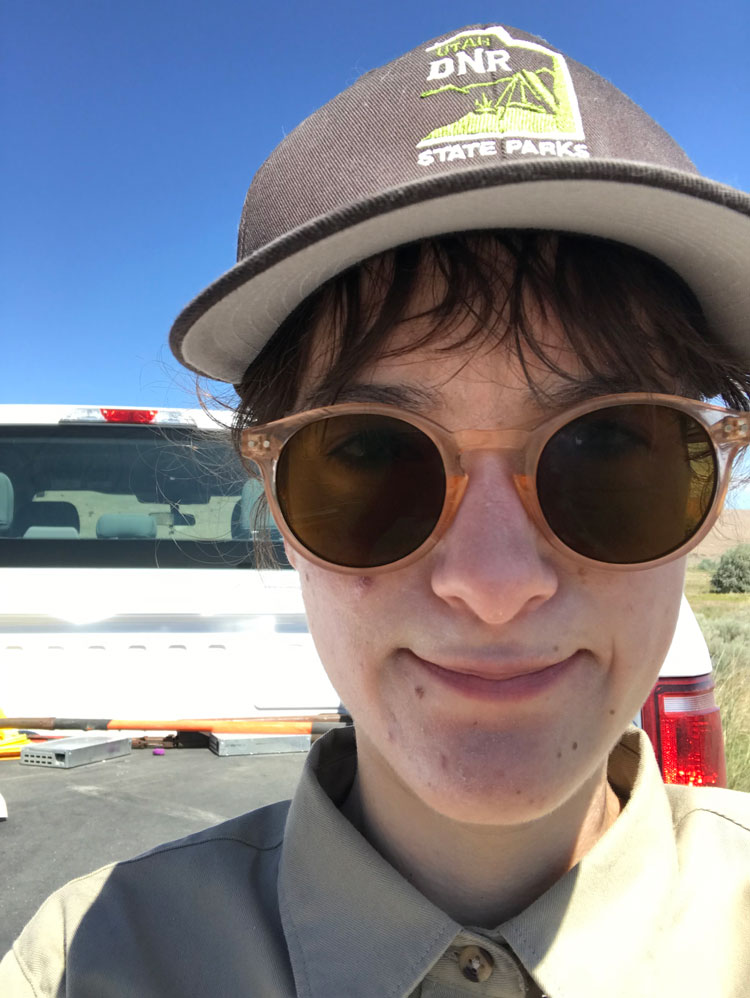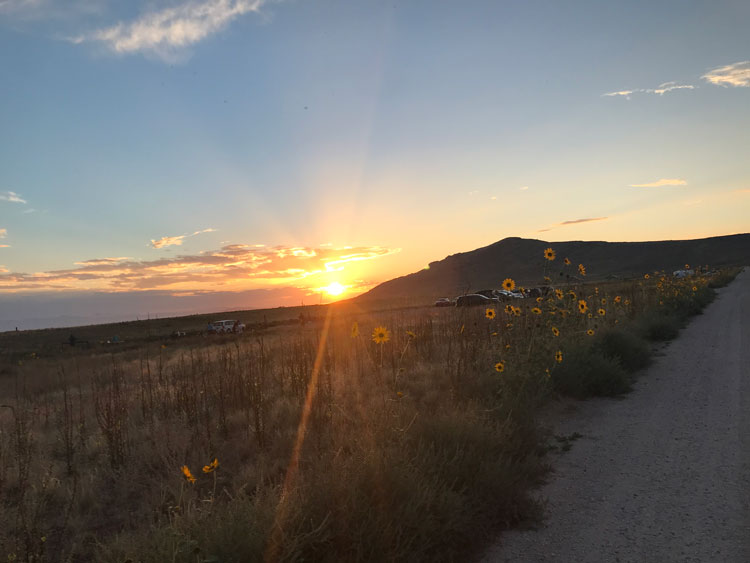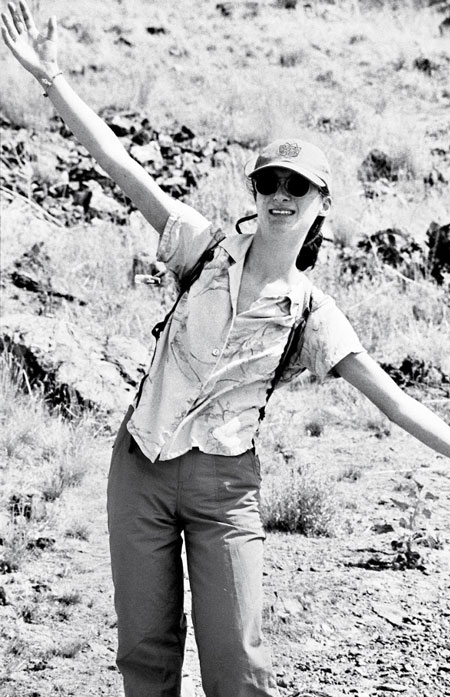Community Engagement Spotlight: Hannah Taub

Second-year student Hannah Taub has been working for Antelope Island State Park as an Interpretive Ranger. She is facilitating a collaboration between the park and the Northwest Band of Shoshone to educate about Indigenous history and futurity of the island. Hannah received a B.A. in Environmental Studies from the Clark Honors College at the University of Oregon in 2018. While there, she published a research paper about the role of religion in snow leopard conservation and completed a thesis on international Indigenous land rights and public lands. In September, I talked with Hannah about her summer at Antelope Island, the partnership with the Northwest Band of Shoshone, and tips for students aiming to do community-engaged research.
Brooke: What have you been working on with Antelope Island State Park and the Northwest Band of Shoshone?
Hannah: I'm working at Antelope Island State Park as an Interpretive Ranger. Part of my goal for that internship was to develop Indigenous programming at the island. So, I reached out to the Northwest Band of the Shoshone Nation. My role has been to facilitate that collaboration between the park and the Northwest Band of Shoshone. I've been meeting with them about once a month. They're located in Ogden close to the park. They were excited about the project because they are developing an interpretive site at the Bear River Massacre location up in Idaho, so this was an opportunity to get the word out about that site and share their culture and interact with the public at another public site. Members of the tribe are going to come out to the Bison Roundup at the park on October 30 and have a table and share their culture with people that are coming to the island for the day. They’re also going to use that opportunity to film the roundup and film interviews with members of the Tribe about Antelope Island memories, because a lot of the elders in the Northwest Band of Shoshone grew up in Syracuse right across the causeway from Antelope Island. The final product for the park is going to be an educational video that'll have interviews that can be shown in the visitor center. I’ll be doing the interviews, and one of the tribe’s members will make the video. Then my master’s project will be an analysis of the whole process of the collaboration.
Brooke: What drew you to get involved with Antelope Island in the first place? What inspired this larger collaboration with the Northwest Band of Shoshone?
Hannah: In the summer of 2020, before I started EH and moved to Utah, it was early in the pandemic, and I had been fired from my restaurant job. So, I was trying to think about how to spend my summer because I knew that I was moving out to Utah from DC, and I didn't have a whole lot of time. I found a posting for interns at Antelope Island. They needed a podcast intern. I had no experience with that, but I knew it was something that I could do virtually. I got the internship, so I learned about the island from a distance and interviewed people over Skype and Zoom for these podcast episodes about topics such as dark skies, wildflowers, and bison. I wanted to do an episode about Indigenous history, because in undergrad I had done a lot of Indigenous history research and work. But my boss didn't really have any suggestions. When I was looking for work for this past summer, I reached out to my supervisor at the park, and she had a position for me. I knew that I wanted to probe that Indigenous history question more. Last spring semester, I also took a class called Indigenous Epistemologies, and I think that helped me realize that to do programming on Indigenous history at Antelope Island, I had to collaborate with an Indigenous community. Now I'm in a class called Indigenous Research Methodologies with the same professor, Cynthia Benally, and it's cool because I get to talk about my project and how I'm trying to apply these methods.
Brooke: How has your relationship with Antelope Island grown over the past year? What does that place mean to you now? What have you learned about it through this collaboration and time on the ground?
Hannah: I came to Utah from DC. When you look up things to do in Salt Lake City, visiting Antelope Island is of the first things that comes up. But my boss always says that many people who are from Utah or Salt Lake have never been to Antelope Island, so it's a popular tourist spot, but not a place a lot of people from here go. I think Antelope Island is unique because as far as I have found, there aren't very many accessible places where you can get right up to the Great Salt Lake. There are factories and there’s not one big recreation area surrounding the whole shore. A lot of the lake is remote. But Antelope Island allows you to get right up to the lake, which is important. Every time I go there, I just think about how much more water there was when I started, and it's already shrinking so rapidly. I wish that more people who lived here knew about Antelope Island and went there and appreciated the Great Salt Lake itself as a thing that we all need. It's beautiful. I kayaked on it, which was super fun. There's obviously so many birds, and it amazes me how much wildlife there is on the island, like coyotes and bobcats. It really does feel like a wild place, even though it's so close to the city. I love it.

Brooke: What was your process for building a partnership with the Northwest Band of Shoshone? What advice do you have for other students hoping to work with Indigenous nations?
Hannah: There’s a lot of negative information around the possibility for collaboration. When I started at Antelope Island and proposed partnering with local tribes, I heard things like, ‘Oh, yeah, I don't do that because it's never been done before, and I've heard it's really hard to contact the tribes.’ There’s kind of a giving up before even starting mentality. So, I guess one word of advice would be that you have to be persistent. I emailed and called different people in the tribal leadership, and it was at least a few weeks before I heard anything back from anyone. Advice I've learned from Greg Smoak, who's done a lot of collaboration with Indigenous communities, is that it's important to go through the tribal leadership and not necessarily just reach out to anyone. I think that’s considered more respectful. So, I reached out to the Northwest Band of Shoshone’s cultural resources coordinator, they set me up with someone as my initial contact, and then I went and met with them at their offices. I've also tried to be flexible and honor people’s time and work around their schedule as much as I can. We always meet in Ogden at their offices. When they want to schedule a time to go see Antelope Island, I make that work. I feel like it has been important to just be respectful of their time. Something I've learned in the Indigenous Research Methods course is the concept of reciprocity. The way that formally plays out in a research setting is that it's expected that you have compensation for Indigenous communities when you work with them. I've applied for grant funding through GCSC to be able to do that. I think that's an important thing to account for.
When I came into this project, I thought I was going to be the one standing up in front of a group of visitors talking about all the research I did on Indigenous history. Now with the video format, I might be doing the interviews, but I won't be telling anyone about anything in any other way - which I felt a little self-conscious about at first because we are taught in Western academia to be very individual and take leadership and ownership of your project. If I wasn't the one talking and being the center of the project, then I worried it would seem like I didn't do enough work. But I've learned that it's more important in the context of working within an Indigenous community to let them lead what shape the project takes and what the content is. Not that I totally took my hands off the wheel and didn't have any part in it, but I just always tried to really listen to what they wanted to get out of the collaboration and what their goals were.
Brooke: What is the value of community engaged research in academia?
Hannah: I think community engaged research has a lot of value in academia, because academia tends to be so insular. Obviously, theory is important, and you don't always have to be doing an applied project. But in the case of Indigenous history, especially as a topic that I chose to pursue, part of what I wanted to emphasize is Indigenous futurity. What I mean by that is that Indigenous communities are still here, and there's sovereign nations here in Utah, in the cities where we live. To emphasize that, I think it was important to have those voices come to the fore. I think that’s the importance of community engaged research in the context of Indigenous history specifically.

